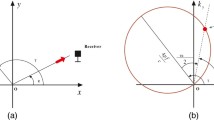Abstract
Wide-angle synthetic aperture radar (W-SAR) imaging accounts for multi-azimuthal scattering and is feasible for retrieving more comprehensive features of complex targets. Because a typical target is seen as composed of its components (typically, some simple geometric objects), a Gaussian amplitude-phase (GAP) model has been developed for the analysis of multi-azimuthal scattering from these objects. Based on the time-frequency analysis of wide-angle scattering, the parameters of the GAP model were estimated, including the Gaussian variance, the surface curvature, and the number of objects in all imaged pixels. Numerical simulations and real measurements demonstrate the capability of the GAP model for decomposing and recognizing complex electric-large targets.
Similar content being viewed by others
References
Moses R L, Potter L C, Çetin M. Wide-angle SAR imaging. In: Proceedings of SPIE in Algorithms for Synthetic Aperture Radar Imagery XI, Orlando, 2004. 5427: 164–175
Lanterman A, Munson D, Wu Y. Wide-angle radar imaging using time-frequency distributions. IEE Proc-Radar Sonar Navig, 2003, 150: 203–211
Ash J N, Ertin E, Potter L C, et al. Wide-angle synthetic aperture radar imaging: models and algorithms for anisotropic scattering. IEEE Signal Process Mag, 2014, 31: 16–26
Ferro-Famil L, Reigber A, Pottier E, et al. Scene characterization using subaperture polarimetric SAR data. IEEE Trans Geosci Remote Sens, 2003, 41: 2264–2276
Duquenoy M, Ovarlez J-P, Ferro-Famil L, et al. Scatterers characterisation in radar imaging using joint time-frequency analysis and polarimetric coherent decompositions. IET Radar Sonar Navig, 2010, 4: 384–402
Duquenoy M, Ovarlez J-P, Ferro-Famil L, et al. Characterization of scatterers by their energetic dispersive and anisotropic behaviors in high-resolution laboratory radar imagery. In: Proceedings of IEEE International Geoscience and Remote Sensing Symposium (IGARSS), Quebec, 2014. 4715–4718
Spigai M, Tison C, Souyris J-C. Time-frequency analysis in high-resolution SAR imagery. IEEE Trans Geosci Remote Sens, 2011, 49: 2699–2711
Dungan K E, Potter L C. Classifying vehicles in wide-angle radar using pyramid match hashing. IEEE J Sel Top Signal Process, 2011, 5: 577–591
Fuller D F, Saville M A. A high-frequency multipeak model for wide-angle SAR imagery. IEEE Trans Geosci Remote Sens, 2013, 51: 4279–4291
Zhao Y, Lin Y, Hong W, et al. Adaptive imaging of anisotropic target based on circular-SAR. Electron Lett, 2016, 52: 1406–1408
Jackson J A, Rigling B D, Moses R L. Canonical scattering feature models for 3D and bistatic SAR. IEEE Trans Aerosp Electron Syst, 2010, 46: 525–541
Rihaczek A W, Hershkowitz S J. Radar Resolution and Complex-Image Analysis. Norwood: Artech House, Inc., 1996
Jackson J A, Moses R L. Synthetic aperture radar 3D feature extraction for arbitrary flight paths. IEEE Trans Aerosp Electron Syst, 2012, 48: 2065–2084
Trintinalia L C, Bhalla R, Ling H. Scattering centre parameterization of wide-angle backscattered data using adaptive Gaussian representation. IEEE Trans Antennas Propag, 1997, 45: 1664–1668
Li J, Ling H. Application of adaptive chirplet representation for ISAR feature extraction from targets with rotating parts. IEE Proc-Radar Sonar Navig, 2003, 150: 284–291
Leducq P, Ferro-Famil L, Pottier E. Matching-pursuit-based analysis of moving objects in polarimetric SAR images. IEEE Geosci Remote Sens Lett, 2008, 5: 123–127
Qian S E, Chen D P. Joint time-frequency analysis. IEEE Signal Process Mag, 1999, 16: 52–67
Çetin M, Ivana S, Onhon N O, et al. Sparsity-driven synthetic aperture radar imaging: reconstruction, autofocusing, moving targets, and compressed sensing. IEEE Signal Process Mag, 2014, 31: 27–40
Davis G, Mallat S, Avellaneda M. Adaptive greedy approximations. Constr Approx, 1997, 13: 57–98
Potter L C, Ertin E, Parker J T, et al. Sparsity and compressed sensing in radar imaging. Proc IEEE, 2010, 98: 1006–1020
Naidu K, Lin L. Data Dome: full k-space sampling data for high-frequency radar research. In: Proceedings of SPIE in Algorithms for Synthetic Aperture Radar Imagery XI, Orlando, 2004. 5427: 200–207
Acknowledgements
This work was supported by National Natural Science Foundation of China (Grant No. 61471127) and Shanghai Yangpu Ding-Yuan Foundation. Y. C. Li is grateful to Dr. A.S. Khwaja for useful discussion on GAP.
Author information
Authors and Affiliations
Corresponding author
Additional information
Conflict of interest The authors declare that they have no conflict of interest.
Rights and permissions
About this article
Cite this article
Li, Y., Jin, YQ. Target decomposition and recognition from wide-angle SAR imaging based on a Gaussian amplitude-phase model. Sci. China Inf. Sci. 60, 062305 (2017). https://doi.org/10.1007/s11432-016-0572-3
Received:
Accepted:
Published:
DOI: https://doi.org/10.1007/s11432-016-0572-3




